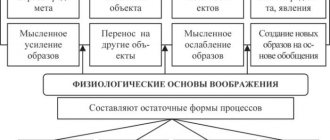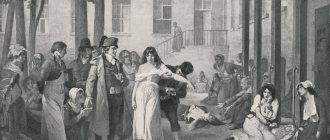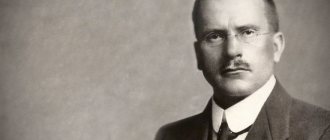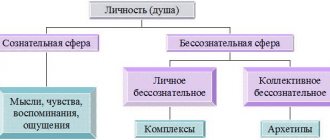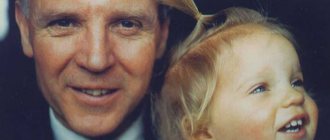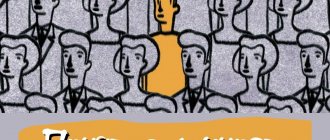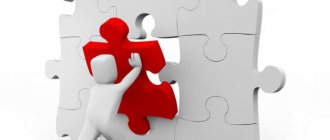Carl Gustav Jung can rightfully be called one of the most outstanding psychotherapists and psychologists of our time. Being a promising and promising student of Sigmund Freud himself, Jung was not afraid to challenge his teacher and move away from the classical theory of personality created by the famous Austrian psychologist. Thanks to the disagreements that arose between teacher and student in 1912, the world learned about Jung’s unusual and rather profound theory of personality.
In the personological tradition, Jung's theory of personality is the most complex, polemical and unorthodox. Unlike Sigmund Freud, whose theory of personality is based on aggression and repressed desires of a sexual nature, Carl Jung built his theory of personality on the basis of deep images or archetypes formed in the process of evolution.
Jung managed to create a unique, original theory of enormous scientific interest, which differs markedly from all other existing approaches to the detailed study of personality. In this article we will consider the main provisions of Carl Jung's theory of personality.
Some interesting biographical facts from the life of Carl Gustav Jung
Carl Gustav Jung was born in 1875 in Switzerland into the family of a Reformed church pastor.
In 1895, the young man entered the University of Basel and began studying medicine there. Five years later, in 1900, Jung not only held the position of assistant to the famous Swiss psychiatrist Eugen Bleuler in one of the psychiatric clinics in Zurich, but also began to communicate with the Austrian psychiatrist Sigmund Freud. After Jung wrote a dissertation in 1903, which dealt with the pathology and psychology of occult phenomena, and published a scientific work on word associations in 1906, a close relationship developed between the already elderly Freud and the young Karl, not only of a professional, but also of a purely friendly nature.
Scientists communicated, were friends and worked together until Jung published his next work on the psychology of the unconscious, libido, symbols and metamorphoses in 1912. The theoretical differences between the basic ideas of Freud and Jung, which were revealed in the new work of Carl Gustav, caused a breakdown in personal and professional relationships.
Neither Freud nor Jung, despite their pre-existing close friendship, could admit that they could simply be wrong. Although Karl did not completely abandon the basic positions of Freudian psychoanalysis, he could not agree that the dominant role in the motivation of any person’s personality is played by sexual desires and aggression. Jung had his own views on concepts such as libido and the unconscious.
Thanks to these views, which differed from Freud's point of view, Jung was able to create a unique theory of personality and an analytical psychology based on selected provisions of classical psychoanalysis.
After a short illness in 1961, Carl Gustav Jung left this world.
Departure from classical psychoanalysis
In 1914, a break occurred between Freud and Jung. And although in general, Jung remains in the position of psychoanalysis, his views on one of Freud’s most basic provisions - on the dominant role of sexual drives in the motivation of the human personality - diverge significantly from the views of his teacher, which leads to irreconcilable contradictions.
There were two reasons for the fundamental divergence: Jung’s own approach to the ideas of libido and the unconscious.
The essence of Jung's theory of personality
To understand what exactly is the essence of Jung's theory of personality, it is necessary to recall the basic principles of Freudian psychoanalysis. Freud argued that the behavior of any person is determined by those unconscious motives that are based on sexual desire. The cause of neuroses, depression and other internal conflicts are the inevitable contradictions between the conscious and unconscious parts of the same personality.
The conscious part of the personality or “super-ego” is in a permanent state of natural contradictions with unconscious impulsive desires conditioned by the animal essence of man, to which Freud gave the name “id.” Why do contradictions arise between the “superego” and the “id”? The whole point is that existing moral, ethical and social guidelines are aimed at suppressing the animal essence of man.
The ideas put forward by Carl Jung regarding the unconscious and libido did not completely coincide with the ideas of Sigmund Freud. Some of the Swiss’s views on the unconscious were based on rather exotic and not entirely acceptable principles for that time.
Although Carl Jung agrees with Freud's idea of libido, he argues that sexual function is not the main function of libido. According to Jung, libido as a source of natural contradiction is not only sexual energy, but some specific mental energy. Sexual energy is just a part of some psychic energy. Sexual need, like any other need, comes to the fore only when it becomes relevant and a priority for a particular individual.
If we consider libido from the point of view of Carl Jung, then the source of psychological problems can be not only unsatisfied sexual need, but also any other need that goes beyond unconscious animal impulses. Jung argued that animal or basic energy manifests itself not only in the field of unconscious animal needs, but also in those activities where a person acts on a conscious level.
Unlike Freud, Jung viewed the motives for personality development in a completely different context. The idea of the Oedipus complex created by Freud is explained by Jung as follows: the child feels a strong attachment to the mother, since it is the mother who satisfies the baby’s basic needs for warmth, safety, food, etc. Sexual energy as a motive becomes relevant during the period of puberty of a child, and not in the first years of his life. Although Jung does not deny that children can experience sexual desire even before the onset of puberty, the Swiss classifies such manifestations as fragmentary. Jung does not consider them separately, but through the prism of other mental needs.
Speaking about what exactly determines the impulses and motives of a person at the current moment in time, Freud argued that the childhood period of development and the experience gained in the past is the basis of human personality. According to Jung, personality development continues throughout life and does not stop in childhood or adolescence.
Jung argued that any person at any age can change in the most dramatic way, therefore his impulses and motives are determined not only by the emotional trauma received in childhood, but also by those current tasks and motives that exist now or will exist in the future.
Personality structure according to Carl Jung
A cursory glance at Jung's personality structure suggests that it is no different from Freud's personality structure. In fact, there are certain differences between them.
Jung states that the personality, soul or psyche of a person consists of three elements: the EGO, the Personal Unconscious and the Collective Unconscious. Let's look at each of the elements in more detail.
• EGO
The EGO is the central part of human consciousness. This part of a person’s consciousness is responsible for personal identification, as it includes sensations, memories, thoughts and feelings. It is thanks to the central part of consciousness that a person perceives himself as a separately existing person, looks at the world rationally and behaves consciously, and does not obey animal instincts.
• Personal unconscious
The personal unconscious can be compared to a container in which once conscious information is stored, but for one reason or another, repressed and forgotten personal information. Jung, unlike Freud, argued that the personal unconscious contains complexes - emotionally charged parts of the psyche that exist almost autonomously. Complexes, being separate mental entities, have a significant impact on the general condition and behavior of a person.
Why do these complexes arise? The reason for their occurrence is those personal traumatic situations that were in opposition to the human ego, and therefore could not be recognized and accepted by it. Such unconscious traumatic situations move into the subconscious over time.
From the conscious part of the personality, unwanted traumatic situations are placed into the personal unconscious with the help of the volitional effort of the EGO. In the personal unconscious, traumatic situations continue to exist. As soon as a person finds himself in a situation similar to the one in which they arose, the traumatic material again reminds itself of itself and “floats” to the surface of consciousness.
Jung believed that for every complex placed in the personal unconscious there is a corresponding belief or idea of an antagonistic nature. Such a belief, which can rightfully be called one of the most important elements of moving the complex into the personal unconscious, is clearly present in the part of the psyche that is conscious to a person.
A person’s free will is violated due to complexes placed in the personal unconscious. A person, having found himself in a certain life situation, does not behave as the existing reality requires, but falls under the influence of one or another internal complex acquired in the past.
To retain traumatic material in the subconscious, a person must constantly spend a large amount of psychic energy. The loss of mental energy causes psychological stress, which negatively affects a person’s daily existence and significantly worsens the quality of his life.
Complexes stored in the personal unconscious have a destructive effect not only on a person’s behavior, but also on a person’s perception of the world. Under the influence of complexes, an individual’s lifestyle, way of thinking and behavior changes.
• Collective unconscious
If traumatic complexes of a personal nature are stored in the personal unconscious, then the collective unconscious is the repository of the common database of all humanity. The collective unconscious stores information about the universal memory of humanity, accumulated over thousands of years of evolution.
This information is the collective heritage of all those people who lived on Earth before us. It exists in the subconscious of each of us in the form of a figurative hidden form. When certain conditions occur, this information becomes available for awareness, but only in the form of certain images (during sleep, hypnosis, etc.).
The collective heritage has its own carriers. The carriers of images of the collective unconscious are archetypes with energetic power and special (sacral) meaning - primary modules or images of the psyche that are responsible for the behavior of people at the instinctive level, their perception of the world around them with the help of those basic principles and ideas that, without having any connection between them, direct connections and despite existing cultural differences, they are practically no different from each other.
Thanks to the collective unconscious, representatives of completely different cultures perceive the same life situation in almost the same way. Jung argued that each archetype bears a certain responsibility for exactly how a certain person or group of people will behave in certain life situations.
Introverts and extroverts
One of Jung's greatest contributions to modern psychology is the introduction of the concepts of extraversion and introversion. He introduced the concepts of extraversion and introversion as the main types of personality orientation (ego orientation).
Extroverts are people who direct libido (vital energy) outward, to external events and other people. They easily make contact with strangers, are communicative, friendly, often very talkative and active. By interacting with others, an extrovert develops as a person, so forced loneliness is difficult for him.
People of this type are usually influenced by their environment, adapt easily to the society in which they live, and are confident in a wide range of different situations.
Introverts are people who direct their libido to the inner world. Such people are prone to contemplation and introspection. They are less susceptible to external influences, less confident in relationships with other people and the outside world, and less socially adaptable than extroverts.
A person with dominant introversion is characterized by isolation, taciturnity, and a tendency toward loneliness. An introvert draws energy from his inner spiritual sources, therefore he avoids large noisy companies.
In each person, such polar types, as a rule, coexist together, however, one of them dominates. However, the dominant type of response depends to some extent on the situation. For example, a usually introverted person may be quite socially flexible in a situation that affects his interests.
Later, Jung complements his theory of psychotypes (psychological types). He believes that all personal differences manifest themselves in four main functions: thinking, feeling, sensation and intuition, with the help of which we can navigate both the external, objective world and the internal, subjective world. Thinking and feeling belong to rational mental functions, and sensation and intuition belong to irrational ones.
Each of us has each of these functions, in addition, each function can be oriented outward or inward and can be extroverted or introverted. In total, we get 8 different mental functions. One of them is the most convenient for adaptation, therefore it is considered the leading one and determines the personality type of the same name according to Jung: thinking, feeling, sensing or intuitive (extroverted or introverted).
Basic archetypes according to Carl Jung
Since there is an unlimited number of repeating (similar, typical) life situations, it is not surprising that the number of archetypes corresponds to the number of life situations. Of all the existing archetypes, Carl Jung identified the following main archetypes: Persona (Mask), Shadow, Anima, Animus, Self. Let's look at each of the archetypes in more detail.
✔ Person
Persona (Mask) is one of the most important archetypes in personality development. A persona is that part of a person’s personality that is aimed at interacting with society.
Thanks to the Mask, a person can come into contact and find a common language with the people around him.
There are many varieties of Persona. Depending on the circumstances, a person can use one or another type of Mask.
The main function of the Persona is to find and imitate that acceptable image of the person himself, which the rest of society can accept. A persona not only contributes to the creation of the desired social image, but also helps to hide from those around them who a person really is.
The mask can rightfully be called that part of an individual’s personality that is responsible for success in the social sphere. But this archetype sometimes carries not only benefits, but also harm. Many people become so fused with this part of their personality that they forget who they really are. The mask begins to enslave the person and turns him into his slave.
The essence of Persona is to constantly change and adapt to the new conditions that arise every now and then in the life of every person.
✔ Shadow
The shadow is an archetype of personality that is responsible for its animal and instinctive part. The shadow represents those sexual, selfish, aggressive and other natural impulses that are rejected by both the person himself and other representatives of society.
Although people tend to suppress the animal part of their personality, Jung argued that the Shadow has a dual essence. This archetype simultaneously combines two aspects that are opposite in meaning: obvious problems for the individual and a powerful source of universal energy. A person can channel this universal energy into a creative direction or use it for any other peaceful purposes.
According to Carl Jung, the Persona and the Shadow are two of the most important archetypes for the individual, which are the basic core (structure) of the collective unconscious. The fact is that the Mask and Shadow, unlike other existing archetypes, are responsible for the individual’s self-awareness, therefore they manifest themselves both in the personal unconscious and on the conscious level.
The task of the EGO is to establish an optimal balance between the Persona and the Shadow and create a certain harmony. This can only happen if the Shadow’s energy is not wasted, but is directed in the right direction, and the Persona is used only as a practical tool for a comfortable social life.
✔ Anima
Anima is a male archetype that is associated with the images of mother and woman. This archetype for males is the ideal of motherhood and demonstrates all those qualities that, according to male logic, an ideal woman must have.
Anima not only represents the ideal of femininity and motherhood, but also personifies that feminine side of any male essence that is located on an unconscious level. It is Anima that has a special influence on a man when he is in search of a partner that is suitable for him.
Anima in the male character manifests itself in the form of irrational and illogical impulsiveness, sensuality and excessive emotional activity. If a man suppresses the Anima in himself, then he will lose an important part of himself, will cease to develop harmoniously and correctly, will feel an oppressive emptiness within himself and will not be able to build a harmonious relationship with a representative of the opposite sex.
✔ Animus
Animus is a female archetype, which represents the ideal image of a man, father, husband, brother. The animus is also the male part of the personality of any female representative.
The animus in a woman's character manifests itself in the form of an active desire for dominance, aggressive and defiant behavior in the circle of close people and society, logical and rational thinking, and independence. If a woman suppresses the animus in herself, then serious disruptions will occur in the development of her personality, which will lead to the fact that the quality of life of such a woman will noticeably deteriorate.
✔ Self
The Self is an archetype that demonstrates what a person really is. In ordinary life conditions, this personality archetype practically does not manifest itself. In order for the Self to become the core of the entire personal structure of an individual, a person must undergo a certain rite, which Jung called Individuation.
Individuation is a special act, thanks to which all internal structures that are contradictory under normal conditions first come into balance, and then unite and become a single harmonious and balanced structure. Only after Individuation does the Self become the defining archetype.
Jung argued that the Self archetype, although it is the main purpose of the existence of any person on planet Earth, is extremely rare. The Self is the embodiment of natural human religiosity in its original form.
Thanks to the Self, which at an unconscious level contributes to the internal development of the individual, the individual’s quality of life improves significantly. A person who has realized the Self enjoys every day of his life and always strives for the best.
Our channel: Yandex Zen
